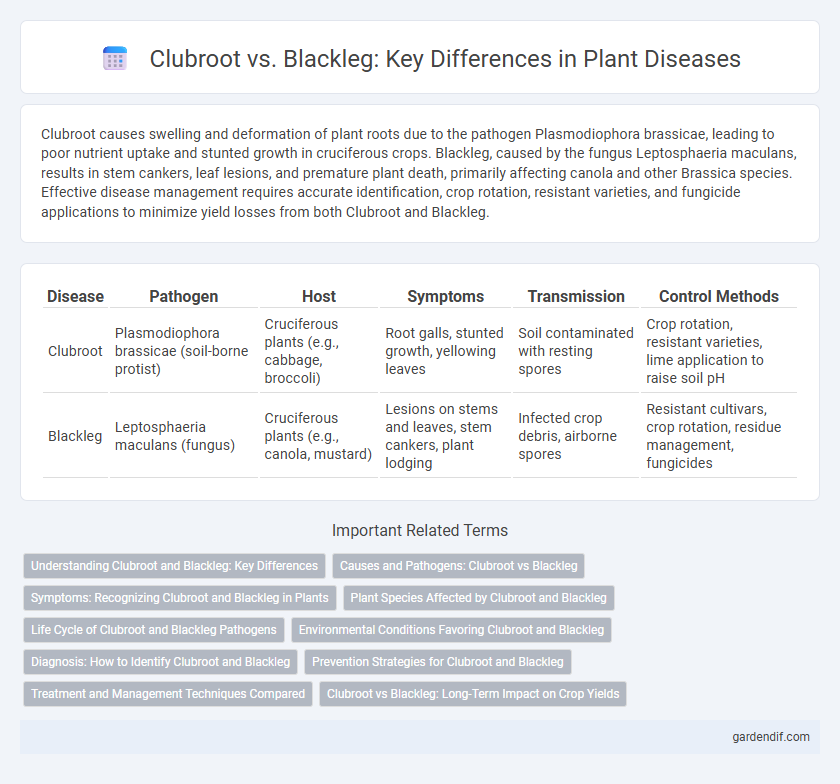
Clubroot vs Blackleg Illustration
Clubroot causes swelling and deformation of plant roots due to the pathogen Plasmodiophora brassicae, leading to poor nutrient uptake and stunted growth in cruciferous crops. Blackleg, caused by the fungus Leptosphaeria maculans, results in stem cankers, leaf lesions, and premature plant death, primarily affecting canola and other Brassica species. Effective disease management requires accurate identification, crop rotation, resistant varieties, and fungicide applications to minimize yield losses from both Clubroot and Blackleg.
Table of Comparison
| Disease | Pathogen | Host | Symptoms | Transmission | Control Methods |
|---|---|---|---|---|---|
| Clubroot | Plasmodiophora brassicae (soil-borne protist) | Cruciferous plants (e.g., cabbage, broccoli) | Root galls, stunted growth, yellowing leaves | Soil contaminated with resting spores | Crop rotation, resistant varieties, lime application to raise soil pH |
| Blackleg | Leptosphaeria maculans (fungus) | Cruciferous plants (e.g., canola, mustard) | Lesions on stems and leaves, stem cankers, plant lodging | Infected crop debris, airborne spores | Resistant cultivars, crop rotation, residue management, fungicides |
Understanding Clubroot and Blackleg: Key Differences
Clubroot, caused by the pathogen Plasmodiophora brassicae, primarily affects the roots of brassica crops, leading to swollen, deformed roots and reduced nutrient uptake, while blackleg, caused by the fungus Leptosphaeria maculans, manifests as stem cankers and leaf lesions, severely impacting plant vascular tissues. Clubroot thrives in acidic, poorly drained soils and has a persistent resting spore stage, making management challenging through crop rotation and liming, whereas blackleg spreads via airborne spores and requires integrated disease management including resistant varieties and fungicide applications. Understanding these distinct life cycles, infection sites, and environmental preferences guides effective control strategies for each disease in agricultural settings.
Causes and Pathogens: Clubroot vs Blackleg
Clubroot is caused by the soil-borne pathogen Plasmodiophora brassicae, which infects the roots of cruciferous plants, leading to swollen and deformed root galls. Blackleg is caused by the fungal pathogen Leptosphaeria maculans, which primarily attacks stems and leaves of Brassica crops, causing stem cankers and lesions. These distinct pathogens result in different disease symptoms and have unique survival and spread mechanisms within infected crop fields.
Symptoms: Recognizing Clubroot and Blackleg in Plants
Clubroot symptoms include swollen, deformed roots with gall formation, leading to wilting and stunted plant growth. Blackleg symptoms manifest as dark, sunken lesions on stems and roots, often accompanied by plant wilting and yellowing leaves. Early detection of these distinct symptoms is crucial for effective disease management in crops like canola and crucifers.
Plant Species Affected by Clubroot and Blackleg
Clubroot primarily affects cruciferous plants such as cabbage, broccoli, cauliflower, and Brussels sprouts, causing swelling and distortion of roots. Blackleg impacts members of the Brassicaceae family, including canola, rapeseed, and cabbage, leading to stem cankers and plant wilting. Both diseases significantly reduce yield and quality in affected crops, making early identification and management critical.
Life Cycle of Clubroot and Blackleg Pathogens
Clubroot, caused by the pathogen Plasmodiophora brassicae, has a life cycle that begins with resting spores surviving in soil for years, which germinate to produce primary zoospores that infect root hairs of cruciferous plants. The pathogen then induces gall formation on roots as secondary plasmodia develop, releasing secondary zoospores to spread the infection and produce new resting spores upon plant decay. Blackleg, caused by Leptosphaeria maculans, initiates infection through ascospores landing on leaf surfaces, leading to lesion formation and the development of pycnidia that release conidia to cause secondary infections; the pathogen survives through the production of pseudothecia on crop residues, completing its sexual phase and producing ascospores for the next infection cycle.
Environmental Conditions Favoring Clubroot and Blackleg
Clubroot thrives in acidic, waterlogged soils with poor drainage, typically under moist, cool conditions favoring the pathogen Plasmodiophora brassicae. Blackleg, caused by Leptosphaeria maculans, prefers well-drained soils with moderate humidity and temperatures between 15-25degC, conditions that facilitate spore germination and infection. Both diseases are influenced by soil pH and moisture, but clubroot is exacerbated by low pH and saturated soils, whereas blackleg develops optimally in neutral pH and slightly drier environments.
Diagnosis: How to Identify Clubroot and Blackleg
Clubroot diagnosis involves observing swollen, distorted roots with galls caused by Plasmodiophora brassicae infection, often confirmed through microscopic examination of spores. Blackleg identification relies on the presence of dark, sunken lesions on stems and petioles, associated with Leptosphaeria maculans, and can be validated by isolating the fungus in laboratory culture. Field signs combined with lab tests provide accurate differentiation between these two critical diseases affecting cruciferous crops.
Prevention Strategies for Clubroot and Blackleg
Preventing Clubroot involves crop rotation with non-host plants, liming acidic soils to maintain pH above 7.2, and using resistant cultivars to reduce pathogen survival. For Blackleg, deploying resistant varieties, practicing crop residue management through deep plowing, and applying appropriate fungicides during crop growth stages are effective. Both diseases benefit from monitoring field conditions regularly to implement timely and targeted control measures.
Treatment and Management Techniques Compared
Clubroot treatment primarily relies on soil pH adjustment through lime application to reduce pathogen viability, combined with resistant crop varieties and crop rotation to limit disease spread. Blackleg management incorporates fungicide seed treatments and the use of resistant cultivars, alongside strict field sanitation and crop rotation to minimize inoculum levels. Both diseases benefit from integrated pest management approaches, yet Clubroot demands more emphasis on soil amendments, while Blackleg control focuses on seed treatment and sanitation.
Clubroot vs Blackleg: Long-Term Impact on Crop Yields
Clubroot, caused by Plasmodiophora brassicae, leads to significant root galling and impaired nutrient uptake, resulting in severe long-term yield reductions in cruciferous crops. Blackleg, induced by Leptosphaeria maculans, causes stem lesions and can lead to premature plant death, which also substantially decreases yield over multiple growing seasons. Crop losses from clubroot tend to persist longer due to soil-borne inoculum survival, whereas blackleg impact can be managed more effectively with crop rotation and resistant varieties.
Clubroot vs Blackleg Infographic

 gardendif.com
gardendif.com